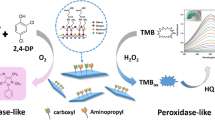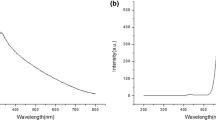Abstract
A host–guest complex of 6-mercaptonicotinic acid (MNA) and cucurbit[7]uril (CB7) was prepared and conjugated to γ-Fe3O4 nanoparticles (NPs) to detect toxic cadmium ions in water as a solid-state sensor. The formation of an inclusion host–guest complex with CB7 was confirmed by UV–vis absorption and proton NMR spectroscopy. CB7 preferentially binds the protonated MNA form compared to the neutral form, demonstrated by a binding constant for the protonated form that is four orders of magnitude higher than that of the neutral form. An increase in the pKa of MNA by 1.2 units was demonstrated after the addition of CB7, which further supports preferential binding between MNA and CB7. The NMR results confirm binding to cadmium via the carboxylic acid moiety. Stationary and time-resolved fluorescence results, in solution and in the solid state, indicate that cadmium and CB7 cause a blue shift in the MNA emission bands and extend its excited-state lifetime due to dissociation of the MNA dimer. In the solid state, switching the emission signals between Cd2+-MNA/CB7NPs (ON state) and MNAH+/CB7NPs (OFF state) was achieved by controlling the pH. An efficient, regenerable, and stable sensor device was fabricated for sensitive and selective detection of Cd2+ in contaminated water samples.

Regeneration of MNA/CB7 nanoparticles for the detection of cadmium ions in the solid state by a visible blue emission signal upon suppression of photoinduced electron transfer (PET).







Similar content being viewed by others
References
Ma X, Zhao Y (2014) Biomedical applications of supramolecular systems based on host–guest interactions. Chem Rev 115:7794–7839
Du X, Zhang X, Jiang C, Zhang W, Yang L (2018) The trace detection of nitrite ions using neutral red functionalized SH-β-cyclodextrin@au nanoparticles. Sensors 18(3):681
Isaacs L (2014) Stimuli responsive systems constructed using cucurbit[n]uril-type molecular containers. Acc Chem Res 47(7):2052–2062
Wang W, Zhang Y, Yang Q, Sun M, Fei X, Song Y, Zhang Y, Li Y (2013) Fluorescent and colorimetric magnetic microspheres as nanosensors for Hg2+ in aqueous solution prepared by a sol-gel grafting reaction and host–guest interaction. Nanoscale 5:4958–4965
Saleh N (2016) New Strategies for the design of inclusion compounds with cucurbituril hosts. In: Non-covalent interactions in the synthesis and design of new compounds. Wiley, Hoboken, pp 228–239
Yu CJ, Wu SM, Tseng WL (2013) Magnetite nanoparticle–induced fluorescence quenching of adenosine triphosphate–BODIPY conjugates: application to adenosine triphosphate and pyrophosphate sensing. Anal Chem 85:8559–8565
Li J, Wang Q, Guo Z, Ma H, Zhang Y, Wang B, Bin D, Wei Q (2016) Highly selective fluorescent chemosensor for detection of Fe3+ based on Fe3O4@ZnO. Sci Rep 6:23558
Kim Y, Lee H, Govindaiah P, Son W, Koh W-G, Cheong I, Kim J (2014) Preparation of Fe3O4-embedded poly(styrene)/poly(thiophene) core/shell nanoparticles and their hydrogel patterns for sensor applications. Materials 7:195–205
Xie C, Xiao L, Peng S, Shi X (2014) Preparation of novel magnetic and fluorescent CS–Fe3O4@CdSeS nanoparticles for simultaneous removal and optical determination of trace copper ions. New J Chem 38:6095–6102
Qazi M, Qureshi I, Memon S (2010) Calix[4]arene based chemosensor for selective complexation of Cd(II) and Cu(II). J Mol Struct 975:69–77
Stevenson L, Adeleye A, Su Y, Zhang Y, Keller A, Nisbet R (2017) Remediation of cadmium toxicity by sulfidized nano-iron: the importance of organic material. ACS Nano 11:10558–10567
Zhang X, Zhao C, Li Y, Liu X, Yu A, Ruan W, Bu X (2014) Two hexaazatriphenylene based selective off–on fluorescent chemsensors for cadmium (II). Talanta 119:632–638
Peng J, Li J, Xu W, Wang L, Su D, Teoh C, Chang Y (2018) Silica nanoparticle-enhanced fluorescent sensor array for heavy metal ions detection in colloid solution. Anal Chem 90:1628–1634
Geng Q-X, Cong H, Tao Z, Lindoy LF, Wei G (2015) Cucurbit[7]uril-improved recognition by a fluorescent sensor for cadmium and zinc cations. Supramol Chem 28:784–791
Niu W-J, Shan D, Zhu R-H, Deng S-Y, Cosnier S, Zhang X-J (2016) Dumbbell-shaped carbon quantum dots/AuNCs nanohybrid as an efficient ratiometric fluorescent probe for sensing cadmium (II) ions and L-ascorbic acid. Carbon 96:1034–1042
Sung Y-M, Wu S-P (2014) Colorimetric detection of Cd(II) ions based on di-(1H-pyrrol-2-Yl)methanethione functionalized gold nanoparticles. Sensors Actuators B Chem 201:86–91
Kang YS, Risbud S, Rabolt JF, Stroeve P (1996) Synthesis and characterization of nanometer-size Fe3O4 and γ-Fe2O3 particles. Chem Mater 8:2209–2211
Masson E, Ling X, Joseph R, Kyeremeh-Mensah L, Lu X (2012) Cucurbituril chemistry: a tale of supramolecular success. RSC Adv 2:1213–1247
Millotti G, Samberger C, Fröhlich E, Bernkop-Schnürch A (2009) Chitosan-graft-6-mercaptonicotinic acid: synthesis, characterization, and biocompatibility. Biomacromolecules 10:3023–3027
Ce S, Zhang K, He J (2011) Synthesis of 2-aminonicotinic acid. J CIESC 62:0438–1158
Xue Y, Zhao H, Wu Z, Li X, He Y, Yuan Z (2011) Colorimetric detection of Cd2+ using gold nanoparticles cofunctionalized with 6-mercaptonicotinic acid and L-cysteine. Analyst 136:3725–3730
Modi RP, Mehta VN, Kailasa SK (2014) Bifunctionalization of silver nanoparticles with 6-mercaptonicotinic acid and melamine for simultaneous colorimetric sensing of Cr3+ and Ba2+ ions. Sensors Actuators B Chem 195:562–571
Wang J, Yu J, Wang X, Wang L, Li B, Shen D, Kang Q, Chen L (2018) Functional ZnS:Mn(II) quantum dot modified with L-cysteine and 6-mercaptonicotinic acid as a fluorometric probe for copper(II). Microchim Acta 185:420
Zhang J, Wang M, Yao X, Deng A, Li J (2014) Highly sensitive electroluminescence immunoassay for Hg(II) ions based on the use of CdSe quantum dots, the methylmercury-6-mercaptonicotinic acid-ovalbumin conjugate, and a specific monoclonal antibody. Microchim Acta 182:469–477
Zhang Y-M, Yang Y, Zhang Y-H, Liu Y (2016) Polysaccharide nanoparticles for efficient SiRNA targeting in cancer cells by supramolecular pKa shift. Sci Rep 6:28848
Liu W, Xu L, Sheng R, Wang P, Li H, Wu S (2007) A water-soluble “switching on” fluorescent chemosensor of selectivity to Cd2+. Org Lett 9(19):3829–3832
Benyettou F, Motte L, Traboulsi H, Mazher J, Pasricha R, Olsen J-C, Trabolsi A, Guenin E (2018) Palladium-loaded cucurbit[7]uril-modified Iron oxide nanoparticles for C−C cross-coupling reactions. Chem Eur J 24:2349–2353
Benyettou F, Nchimi-Nono K, Jouiad M, Lalatonne Y, Milosevic I, Motte L, Olsen J-C, Saleh N, Trabolsi A (2015) Viologen-templated arrays of cucurbit[7]uril-modified iron-oxide nanoparticles. Chem Eur J 21:4607–4613
Li X, Xie C, Xia H, Wang Z (2018) pH and ultrasound dual-responsive polydopamine-coated mesoporous silica nanoparticles for controlled drug delivery. Langmuir 34:9974–9981
Funding
UPAR (3) 2019 and SURE +2019 from UAE University.
Author information
Authors and Affiliations
Contributions
HM prepared and characterized (FTIR) the MNA/CB7 and MNA with cadmium in the solid state. FB and AT prepared and characterized (FTIR and TGA) the MNA/CB7NPs. RA and NS created the idea, wrote the manuscript, and conducted all other experiments. All authors have given approval to the final version of the manuscript.
Corresponding author
Ethics declarations
Conflict of interest
The authors declare that they have no competing interests.
Additional information
Publisher’s note
Springer Nature remains neutral with regard to jurisdictional claims in published maps and institutional affiliations.
Electronic supplementary material
ESM 1
Supporting information. This material is available free of charge via the Internet at. (DOCX 16412 kb)
Rights and permissions
About this article
Cite this article
Alzard, R.H., Meyer, H., Benyettou, F. et al. pH-controlled preferential binding of cucurbit[7]uril-coated iron-oxide nanoparticles to 6-mercaptonicotinic acid for fluorescent detection of cadmium ions in the solid state. Microchim Acta 187, 386 (2020). https://doi.org/10.1007/s00604-020-04354-z
Received:
Accepted:
Published:
DOI: https://doi.org/10.1007/s00604-020-04354-z




